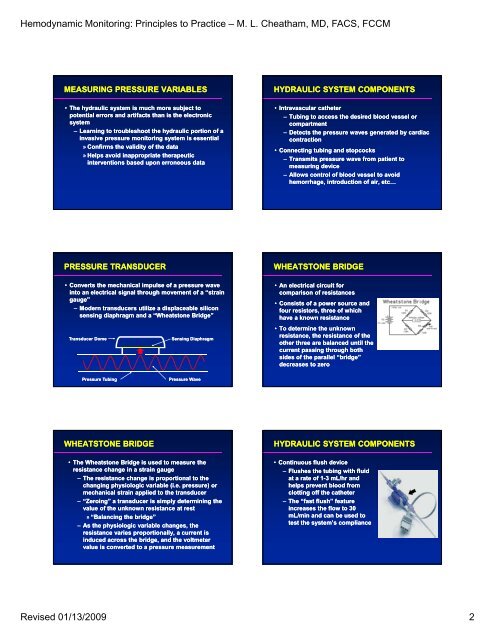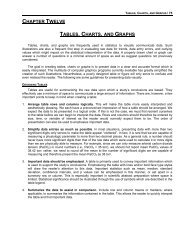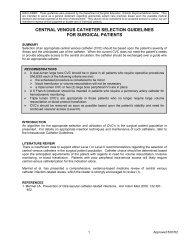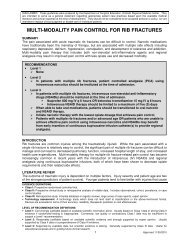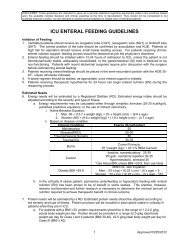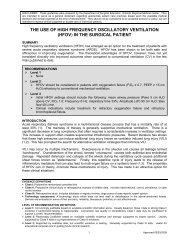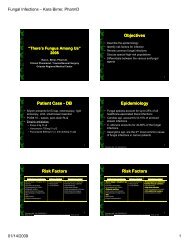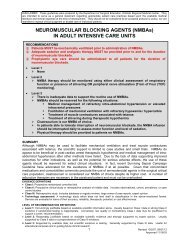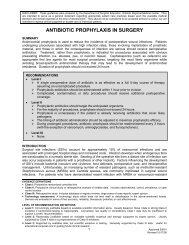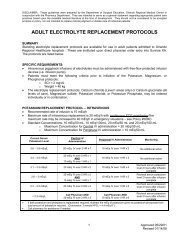Hemodynamic Monitoring: Principles to Practice â M. L. Cheatham ...
Hemodynamic Monitoring: Principles to Practice â M. L. Cheatham ...
Hemodynamic Monitoring: Principles to Practice â M. L. Cheatham ...
Create successful ePaper yourself
Turn your PDF publications into a flip-book with our unique Google optimized e-Paper software.
<strong>Hemodynamic</strong> <strong>Moni<strong>to</strong>ring</strong>: <strong>Principles</strong> <strong>to</strong> <strong>Practice</strong> – M. L. <strong>Cheatham</strong>, MD, FACS, FCCMMEASURING PRESSURE VARIABLES• The hydraulic system is much more subject <strong>to</strong>potential errors and artifacts than is the electronicsystem– Learning <strong>to</strong> troubleshoot the hydraulic portion of ainvasive pressure moni<strong>to</strong>ring system is essential» Confirms the validity of the data» Helps avoid inappropriate therapeuticinterventions based upon erroneous dataHYDRAULIC SYSTEM COMPONENTS• Intravascular catheter– Tubing <strong>to</strong> access the desired blood vessel orcompartment– Detects the pressure waves generated by cardiaccontraction• Connecting tubing and s<strong>to</strong>pcocks– Transmits pressure wave from patient <strong>to</strong>measuring device– Allows control of blood vessel <strong>to</strong> avoidhemorrhage, introduction of air, etc…PRESSURE TRANSDUCER• Converts the mechanical impulse of a pressure wavein<strong>to</strong> an electrical signal through movement of a “straingauge”– Modern transducers utilize a displaceable siliconsensing diaphragm and a “Wheats<strong>to</strong>ne Bridge”Transducer DomeSensing DiaphragmWHEATSTONE BRIDGE• An electrical circuit forcomparison of resistances• Consists of a power source andfour resis<strong>to</strong>rs, three of whichhave a known resistance• To determine the unknownresistance, the resistance of theother three are balanced until thecurrent passing through bothsides of the parallel “bridge”decreases <strong>to</strong> zeroPressure TubingPressure WaveWHEATSTONE BRIDGE• The Wheats<strong>to</strong>ne Bridge is used <strong>to</strong> measure theresistance change in a strain gauge– The resistance change is proportional <strong>to</strong> thechanging physiologic variable (i.e. pressure) ormechanical strain applied <strong>to</strong> the transducer– “Zeroing” a transducer is simply determining thevalue of the unknown resistance at rest» “Balancing the bridge”– As the physiologic variable changes, theresistance varies proportionally, a current isinduced across the bridge, and the voltmetervalue is converted <strong>to</strong> a pressure measurementHYDRAULIC SYSTEM COMPONENTS• Continuous flush device– Flushes the tubing with fluidat a rate of 1-3 mL/hr andhelps prevent blood fromclotting off the catheter– The “fast flush” featureincreases the flow <strong>to</strong> 30mL/min and can be used <strong>to</strong>test the system’s complianceRevised 01/13/20092


